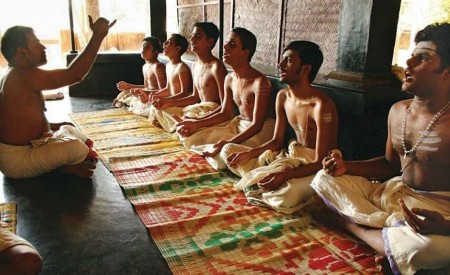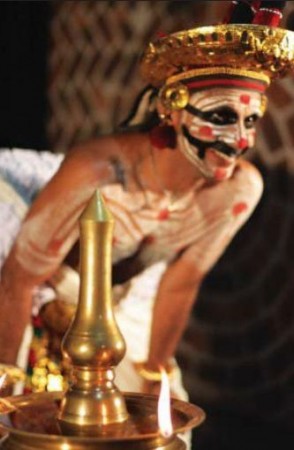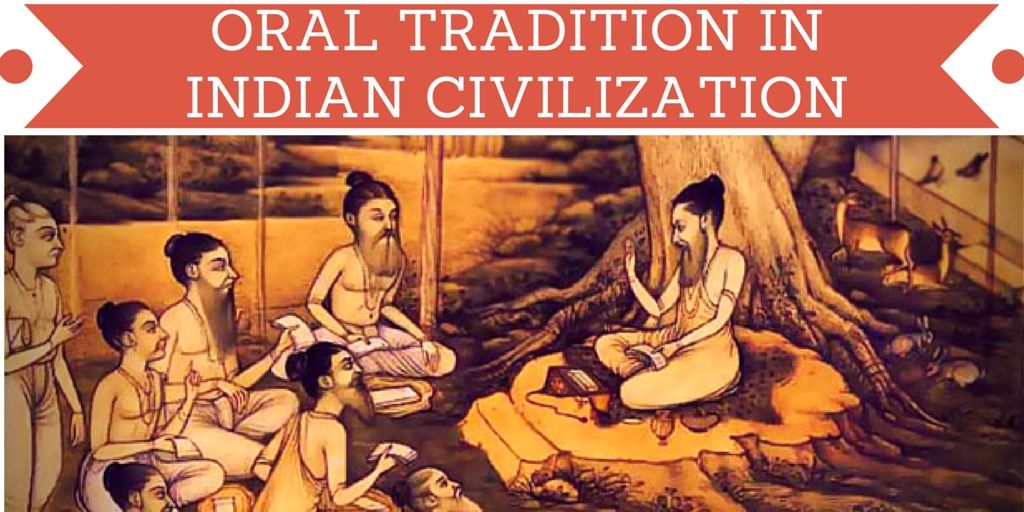In India, oral transmission of knowledge still continues to be the most important method by which we communicate messages, educate our children on early lessons, learn our scriptures and texts, transmit our stories and nurture knowledge about life and art.
All cultures have found ingenious ways to pass on their knowledge systems, through developing formal and informal ways of communication and preservation. Most pre-written cultures had developed systems of transmission of their knowledge such as Homer’s poetry, or the Christian gospel spreading by word of mouth through the apostles of Christ down to the early Christian era. The oral tradition of West Africa was to propagate their stories, and epics by establishing a class of people who took on the task of memorizing and handing down that knowledge to succeeding generations. The markers of this memory consisted of symbols, codes and images that represented different facets of knowledge. Many societies across the world developed elaborate mnemonic devices and formal rituals which became part of remembering and recollecting knowledge in domains such as tales, parables, proverbs, songs and legends, skills pertaining to arts, healing and medicine.
When we examine some significant ways in which India preserved and transmitted its knowledge, we see that lndia’s oral tradition has followed both fixed and floating patterns of transmission, in codified and un-codified forms. While the knowledge contained in the Vedas and its ancillary branches came to be transmitted through an established, meticulous code of memorization, a parallel dimension of non—structured, free transmission also existed side by side. Often these two traditions are seen to interact, respond and support each other, because they emerge from the large stock of the shared wealth of a collective imagination.
While the codified system of handing down Vedic corpus became dependent on an organized system of learning through the guru-shishya parampara, the narrative-performative tradition of recitation carried on the dissemination of much of our indigenous knowledge. Much of India’s myths and epics such as the Mahabharata and the Ramayana, tales and fables such as Kathasaritsagara and Jataka stories, ballads, legends, songs, and a multitude of knowledge and skill in every field were carried on through a largely flexible mode of communication, which extends the narrative through interpolations, conscious extensions and embedding sub-narratives. Even if there was an early written tradition, it was believed that “pustakeshu cha yaa vidya/parahastagatam dhanam/samaye tu paripraapte/na saa vidyaa na taddhanam” (the knowledge from books and money gone to another person are not useful, because they cannot come to one’s aid when needed).
The mode of oral narration of stories goes back a long way in India. We find that many later texts, which later came to be fixed through the written form, existed as floating stories and versions in specific local milieus. These stories have considerable freedom of interpretation depending on the skill and creative imagination of the narrator, and are open-ended and collaborative, rather than fixed and inflexible. Even when the basic story remain the same, the interpretation changes according to who says it, where it is said and how it is said.
In India, there were professional storytellers attached to the temples who narrated stories from the Ramayana and the Mahabharata. A class of itinerant story-tellers told and retold the epics, Puranas legends not merely in the temples but in public spaces across the coutry. Diffrent texts and traditions emerged with local variations and stories and sub-stories began to be integrated into the main plot. With the interpretative skills of the story-tellers, even complex ideas in the Ramayana and the Mahabharata became accessible to a wider audience. Apart from embellishing the same story through sub-narratives, another device of story telling that became popular in India was the stringing of several stories into the same narrative structure; tales and fables such as kathasaritsagara, Panchatantra and Brhadkatha provided a single frame in which multiple stories were embedded.

A powerful instance of narration of the oral tradition of story-telling is Prabandha Koothu from Kerala, which in dovetailed into Kutiyattam, the Sanskrit theatre. The comic character Vidushaka, the protagonist verbally elaborates diffrent episodes and stories from the epics in Malayalam, a language that was accessible to all levels of people. While narrating the story, the actor spins new stories and anecdotes into the main plot, with copious references to contemporary situations, and the actor directs his attention through ridicule to members of the audience also. Couched in the guise of relating to the texts, the actor through the medium of humour makes references to topical incidents, and the immediacy of the situation become highly entertaining to the audience. The introduction of the ‘Prabandhas’ written by eminent poets like Melpattur Narayana Bhattathiri also enlarged his repertoire. However, irrespective of the nucleus of the text, oral content become the real text in Prabandha Koothu.
Performative elements such as singing and dancing are also popular devices to reach out to audiences. Folks and regional performances like Ramlila, Pandvani and a host of other performances across India also popularized these stories and excited. Ramlila, the story of divine play of Lord Rama, has diverse representations across India and is generally based on the text of Tulsidas’s Ramacharitmanas.




Destroying the Shroutha (heard) and Smartha (remembered Brahmin traditions is what the British began after 1857,and their native stooges refined after 1921, but accomplished only in the last sixty years. They replaced the oral traditions whith haphazard and distorted books and the Brahmin law and guidance with a thousand cults.